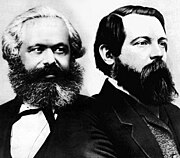Wage Labour and Capital
This article needs additional citations for verification. (October 2011) |
| Part of a series on |
| Marxism |
|---|
 |
|
"Wage Labour and Capital" (German: Lohnarbeit und Kapital) is an 1847 economics essay by Karl Marx, first published in articles in the Neue Rheinische Zeitung in April 1849. It is widely considered the precursor to Marx’s influential treatise Das Kapital.[1] It is commonly paired with Marx's 1865 speech Value, Price and Profit.
Description[]
The ideas expressed in the essay have a thorough economic contemplation about them as Marx put aside his materialist conceptions of history for the time being. This essay began developing a more scientific rationale for his concept of alienated labor which in Marx’s perspective would eventually lead to the proletarian revolution.
Main topics examined in the essay include labour power, labour, and how labour power becomes a commodity. The labour theory of value is introduced, which distinguishes between labour and labour power. The essay defines the term commodity and explores how the economic principles of supply and demand affect the pricing of certain commodities. Beyond that, the essay explores how capital and capitalism do not service any purpose other than to gain more of it, which Marx presents as an illogical method of living one's life.
Thus, "Wage-Labor and Capital" is considered by Marxists as an "in-depth economic and scientific observation on how capitalist economy works, why it was exploitative, and ultimately why it would eventually implode from within".[2]
References[]
- ^ Marx, Karl; Engels, Friedrich (1978). Tucker, Robert C. (ed.). The Marx-Engels Reader (2nd ed.). London: W. W. Norton & Company. p. 203. ISBN 978-0-393-09040-6.
It may be said that what Marx produced in the lectures of late 1847 was the future argument of Capital in embryo.
- ^ "Amazon". www.amazon.com. Retrieved 2021-01-12.
External links[]
| Wikisource has original text related to this article: |
- Online text of this essay
 Wage-Labour and Capital public domain audiobook at LibriVox
Wage-Labour and Capital public domain audiobook at LibriVox
- Books by Karl Marx
- 1849 books
- 1849 in economics
- 1849 essays